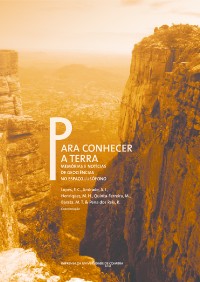Please use this identifier to cite or link to this item:
https://hdl.handle.net/10316.2/31380| DC Field | Value | Language |
|---|---|---|
| dc.contributor.author | Cardoso, F. M. C. | |
| dc.contributor.author | Sá, E. F. Jardim | |
| dc.contributor.author | Silva, F. C. Alves da | |
| dc.date.accessioned | 2014-06-19T14:10:49Z | |
| dc.date.accessioned | 2020-09-18T16:04:12Z | - |
| dc.date.available | 2014-06-19T14:10:49Z | |
| dc.date.available | 2020-09-18T16:04:12Z | - |
| dc.date.issued | 2012 | - |
| dc.identifier.isbn | 978-989-26-0534-0 (PDF) | |
| dc.identifier.uri | https://hdl.handle.net/10316.2/31380 | - |
| dc.description.abstract | The Araripe Basin is related to the fragmentation of the Gondwana supercontinent and the opening of the South Atlantic Ocean. The basin is part of the Cariri-Potiguar Trend, an aborted branch of the neocomian rifting in Northeast Brazil. It rests upon the precambrian terrains of the Transversal Zone, Borborema Province, immediately to the south of the Patos Lineament. The basin comprises a set of NE-trending grabens and horsts controlled by the NW-SE eocretaceous crustal stretching. The Palestina Graben is located in the eastern portion of the Araripe Basin. It presents an asymmetric geometry according to the half-graben style. The SE border is a flexural margin, characterized by the non conformity of the eopaleozoic Mauriti Formation (the oldest unit of the basin), overlying the crystalline basement; the stratigraphic sequences are affected by normal to oblique faults with small displacements. On the opposite, the NW border is well defined by normal faults with major displacements, which control the general tilting of the layers to the NW. Strike-slip or oblique-slip faults are also compatible with the NW-SE extension. The interpretation of available gravity data and a seismic section indicates that the main fault has a variable dip slip component, defining two deeper portions within the graben, in which the sedimentary column can reach thicknesses of up to 2 km | eng |
| dc.description.abstract | A Bacia do Araripe está relacionada com a fragmentação do supercontinente Gondwana e a abertura do Atlântico Sul. A bacia faz parte do Alinhamento Cariri-Potiguar, um ramo abortado do rifetamento neocomiano no Nordeste do Brasil. A mesma repousa sobre os terrenos pré-cambrianos da Zona Transversal, Província Borborema, imediatamente a sul do Lineamento Patos. A bacia é constituída por um conjunto de grabens e horsts com direção NE, condicionada pela orientação NW-SE dos esforços de estiramento crustal eocretáceo. O Graben de Palestina está localizado na porção leste da Bacia do Araripe. Apresenta uma geometria assimétrica, em estilo de semi-graben. A borda SE constitui uma margem flexural, caracterizada pelo contacto em não conformidade da Formação Mauriti (a unidade mais antiga da bacia) com o embasamento cristalino; as sequências estratigráficas são seccionadas por falhas normais a oblíquas, de rejeito moderado. Já a borda NW é bem definida, marcada por falhas normais com rejeito significativo, que controlam o basculamento das camadas para NW. Falhas de rejeito direcional ou oblíquo são também compatíveis com a distensão NW-SE. A interpretação dos dados gravimétricos e de uma linha sísmica indicam que a falha principal tem rejeito variável, definindo duas porções mais profundas no graben, nas quais a coluna sedimentar pode atingir espessuras de até 2 km | por |
| dc.language.iso | por | - |
| dc.publisher | Imprensa da Universidade de Coimbra | por |
| dc.relation.ispartof | Http://hdl.handle.net/10316.2/24406 | por |
| dc.rights | open access | - |
| dc.subject | Graben | eng |
| dc.subject | Structural style | eng |
| dc.subject | Araripe Basin | eng |
| dc.subject | NE Brazil | eng |
| dc.subject | Graben | por |
| dc.subject | Estilo estrutural | por |
| dc.subject | Bacia do Araripe | por |
| dc.subject | NE Brasil | por |
| dc.title | O Graben de Palestina (Bacia do Araripe, NE Brasil): análise estrutural | por |
| dc.title.alternative | The Palestina Graben (Araripe Basin, NE Brazil): structural analysiss | eng |
| dc.type | bookPart | por |
| uc.publication.firstPage | 33 | - |
| uc.publication.lastPage | 40 | - |
| uc.publication.location | Coimbra | por |
| dc.identifier.doi | 10.14195/978-989-26-0534-0_3 | - |
| uc.publication.digCollection | PB | por |
| uc.publication.orderno | 3 | - |
| uc.publication.area | Artes e Humanidades | por |
| uc.publication.bookTitle | PAra conhecer a Terra: memórias e notícias de Geociências no espaço lusófono | - |
| uc.publication.manifest | https://dl.uc.pt/json/iiif/10316.2/31380/218451/manifest?manifest=/json/iiif/10316.2/31380/218451/manifest | - |
| uc.publication.thumbnail | https://dl.uc.pt/retrieve/11293800 | - |
| uc.publication.parentItemId | 52124 | - |
| uc.itemId | 71830 | - |
| item.grantfulltext | open | - |
| item.fulltext | With Fulltext | - |
| Appears in Collections: | Para conhecer a Terra: memórias e notícias de Geociências no espaço lusófono | |
Files in This Item:
| File | Description | Size | Format | |
|---|---|---|---|---|
| 3-para_conhecer_a_terra_artigo.pdf | 2.62 MB | Adobe PDF |  |
Items in DSpace are protected by copyright, with all rights reserved, unless otherwise indicated.
